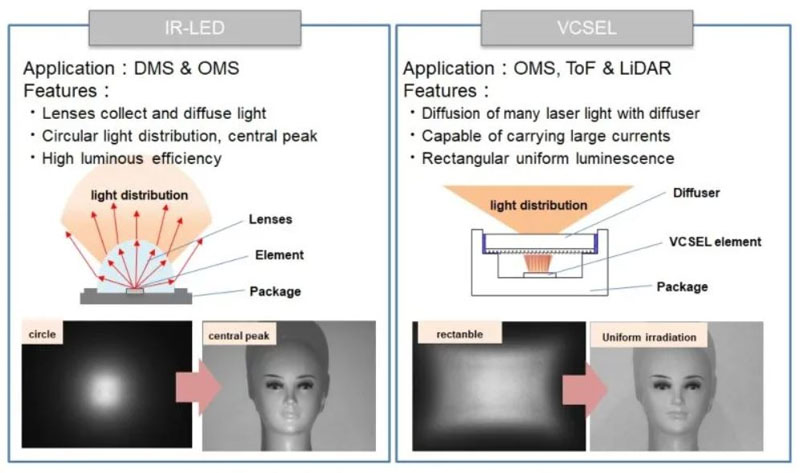NEWS
NEWS
Both Infrared VCSELs and infrared LEDs are required by different automotive applications
25-11-2023
Infrared VCSELs are a semiconductor laser unit that emit laser light vertically from the substrate. They have high directivity, less impact of temperature conditions or the way they illuninate stably. As their emission spectrum is much narrower than that of infrared LEDs, the passband of a band-pass filter can be made tighter to suppress effects of sunlight.
The beam pattern of LEDs is strongest in the center and that spreads around a circle. Infrared VCSELs use a diffuser to scatter the laser light in order to achieve wide-angle, uniform illumination in the view, while at the same time preventing focused laser to ensure safety for the human eye. Compared with LEDs that are combined with lenses to gather or disperse light and provide wide illumination of spaces, infrared VCSELs use diffusers to scatter light and uniformly illuminate the surface of rectangular shapes. High-resolution sensing required for DMS/OMS, is achieved by this infrared VCSEL characteristic of uniformly illuminating rectangular shapes to illuminate the FoV of the camera evenly.
The response speed of an infrared VCSEL is significantly higher than that of an LED. Pulse rise and fall times for LEDs are 10-15n sec, but at 1 nsec for infrared VCSELs. Thus, VCSELs respond 10 times faster than LEDs by simple calculation. When used as the light source for a ToF sensor, a VCSEL can achieve higher ToF image resolution, wider angles, and closer to real-time performance (lower latency) than an LED light source. Based on these characteristics,infrared VCSELs are the best choices for applications such as 3D sensing for OMS, or recognizing in 3D extraordinarily complex movements and gestures of the driver and using them as feedback to control the vehicle.
Infrared VCSELs with high-speed responses are well suited to certain applications, such as ToF sensors and gesture control, but there is still considerable demand for infrared LEDs, which have already proven in the market, and which are economical than infrared VCSELs.
26 auto manufacturers and 30 different types of platforms have adopted infrared VCSEL and infrared LED designs. More than 20 other projects are currently being proposed or evaluated.Facing mandating of DMS for vehicles in China, many auto makers have been active to adopt DMS and OMS, which results in that more infrared VCSELs are already used in the vehicles of multiple Chineseautomotive manufacturers.
Like Chinese market, European market also sees the growing number of vehicles equipped with DMS/OMS.Both VCSELs and infrared LED light sources will be a reassuring alloy for designers of DMS/OMS, who face more differtiated specifications of sensor light sources on the market.

The beam pattern of LEDs is strongest in the center and that spreads around a circle. Infrared VCSELs use a diffuser to scatter the laser light in order to achieve wide-angle, uniform illumination in the view, while at the same time preventing focused laser to ensure safety for the human eye. Compared with LEDs that are combined with lenses to gather or disperse light and provide wide illumination of spaces, infrared VCSELs use diffusers to scatter light and uniformly illuminate the surface of rectangular shapes. High-resolution sensing required for DMS/OMS, is achieved by this infrared VCSEL characteristic of uniformly illuminating rectangular shapes to illuminate the FoV of the camera evenly.
The response speed of an infrared VCSEL is significantly higher than that of an LED. Pulse rise and fall times for LEDs are 10-15n sec, but at 1 nsec for infrared VCSELs. Thus, VCSELs respond 10 times faster than LEDs by simple calculation. When used as the light source for a ToF sensor, a VCSEL can achieve higher ToF image resolution, wider angles, and closer to real-time performance (lower latency) than an LED light source. Based on these characteristics,infrared VCSELs are the best choices for applications such as 3D sensing for OMS, or recognizing in 3D extraordinarily complex movements and gestures of the driver and using them as feedback to control the vehicle.
Infrared VCSELs with high-speed responses are well suited to certain applications, such as ToF sensors and gesture control, but there is still considerable demand for infrared LEDs, which have already proven in the market, and which are economical than infrared VCSELs.
26 auto manufacturers and 30 different types of platforms have adopted infrared VCSEL and infrared LED designs. More than 20 other projects are currently being proposed or evaluated.Facing mandating of DMS for vehicles in China, many auto makers have been active to adopt DMS and OMS, which results in that more infrared VCSELs are already used in the vehicles of multiple Chineseautomotive manufacturers.
Like Chinese market, European market also sees the growing number of vehicles equipped with DMS/OMS.Both VCSELs and infrared LED light sources will be a reassuring alloy for designers of DMS/OMS, who face more differtiated specifications of sensor light sources on the market.



